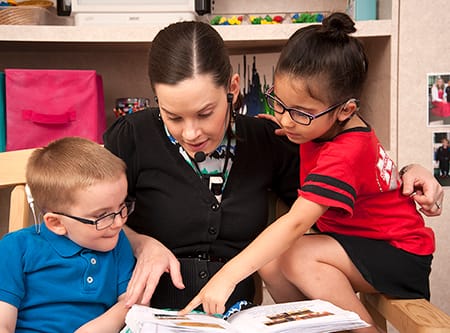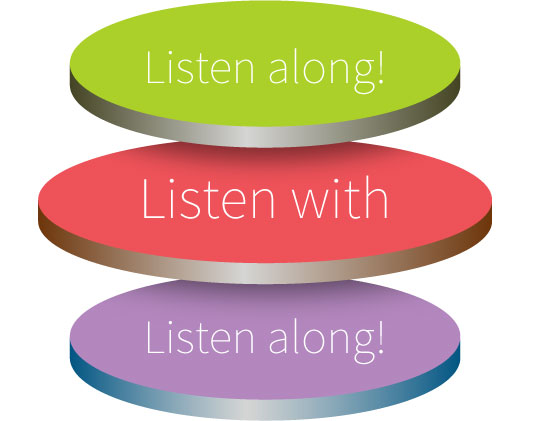Story time is a time to stay close and communicate about something that is interesting and exciting. Story time is also a time for baby to listen with amplification and begin to make sense of sound.
-
Experiencing different sounds in speech: early books call for parents' voices to go up and down, to be loud and soft, squeaky and smooth.
-
Identifying different noises and sounds: early books have animal noises, vehicle noises, funny voices and more to help make reading fun
-
Practicing listening: this will help your baby develop speech sounds and voice control
Reading is not the only time that you will communicate and your baby will listen, but it is a very important time. Be sure that hearing aid and/or cochlear implant devices are working well so your child is "on the air" for the precious time you will share books together.

Place Yourself Close and Let the Child Look and Listen
Give your baby or your toddler a chance to look at the book and listen to what you are saying.
Some little ones are learning language mostly by listening to what is said. If that is true of your little one, you have some options.
- Sit beside your little one when she is in her high chair. This puts you close to her device microphone and on the same level.
- Speak naturally and colorfully as you talk about the book. She may or may not look at you for more information.
- You may also seat the child in your lap with the book in front of you; if your child sits up straight, you can be close to her device microphones.
- You can repeat and point to help your child connect what is heard with what is in the book.
If speechreading is part of your communication approach, give the child a chance to look at your face.
- You can cue your baby to focus on your face or on the book by pointing, or changing your voice suddenly.
- To do this, you will need to sit in the corner of a couch, or with your baby diagonally in your lap, with the book slightly to the side.
Encourage Your Baby to Communicate About the Book
What is your baby looking at, or pointing to, or trying to say about a picture?
- Because we rarely read books just once, your baby will gradually begin to repeat favorite words and phrases, or correct you if you forget them or say them wrong.
- Communicating about stories and picture books is one of the great pleasures of reading to our babies and children.
- It also is an important part of developing literate language for later reading in school.
Some Strategies for "Tuning In" On Language and Listening
Parents of children who are deaf or hard of hearing use some special strategies to promote listening and understanding. The words in
orange are said a little louder with a bit more emphasis.
Highlighting
Highlighting means making an important word stand out by making it a little louder. Suppose your child loves trucks. He points to a picture of a truck in a book and says, "truck!" You can stretch his idea and highlight the new information…."Yes, a
BIG truck." It is a
DUMP truck."
Lowlighting
Lowlighting is the opposite of highlighting. You are close to your child and you speak softly or even in a whisper. Young children can find this really interesting and they will listen intently. "Let's put your dolly to bed…" Then in a whisper say, "…shhhhhh baby is sleeping." You will know your child is hearing a whisper when he or she tries to copy you!
Repetition
Use repetition for emphasis. When you repeat, your child gets additional chances to hear the word and make a connection between the word and the picture. So, you are looking at an elephant in a book. "See the
elephant?
Elephants are big. That
elephant has a hat!"
Auditory Sandwiching
This is a really helpful strategy if your child needs a little extra support to understand.
Step 1: Child Listens without Visual Cues: the child is only listening to you and not looking: "See the shoe?" (said in that side-by-side position)
Step 2: Child Listens with Support of Visual Cues: If the child looks confused or does not point, you can add a chance for the child to look and listen. Invite your child to look at your face to
add speechreading or sign language if your family is using sign support. For those families who are not using sign language, visual cues can be provided by using natural gestures, emphasizing face-to-face communication, and referring to the objects, pictures, or print.
Step 3: Child Re-Listens without Visual Cues: Here's the good part! Repeat the phrase through listening alone: "See the shoe?" Often this gives the child auditory challenges, but the supports help the message make sense. Gradually, the child will not need the support, but the sandwich strategy is always there when you need it.

Tell and Show
Instead of "show and tell" try it the other way around.
For example, if your child is learning the phrase, "turn the page" – you can encourage your child to make this connection by saying, "turn the page." Then wait a moment and show the child what you mean – demonstrate turning the page – while saying, "We can turn the page."
Play with Sound Patterns and Sound Effects
Book reading can be a wonderful time to play with sound effects. When children are learning to listen, these natural sound effects provide interesting patterns and contrasts to listen to. The train says "chooo-chooo-chooo," but the baby says, "WAHHHHHHHH." Bunnies can hop-hop. These sound contrasts are fun and help build sound-meaning associations.
Notice how this little girl is learning the Old MacDonald song after reading the same book with her parents over and over again. Although she does not know or pronounce each word, she is clearly picking up on the melody and enjoying this fun book sharing game.
WAIT for a Response
Sometimes you will say something, and your child just needs a little time to process…to figure out what you said. As adults, we are wise to give the child a little "wait" time. That wait time gives your child an opportunity to think and respond.
Some Final Thoughts
- Children who are deaf or hard of hearing who are learning spoken language need to experience books in a quiet environment –
turn off the TV and limit other background noise if you can
-
Repeat, repeat, repeat! Children need to hear the words, sounds and stories again and again
- While you are reading, your baby is working hard to make sense out of what you are saying, but the work is fun
- The more you read together, the more your baby can practice listening
- Parents and family members who read regularly to your baby not only help develop listening and spoken language, they help promote literacy
Suggested Readings:
Children With Hearing Loss - Developing Listening and Talking, 2nd Edition, Elizabeth B. Cole & Carol Flexor (Plural Publishing, Inc., 2011)
Literacy and Deafness: Listening and Spoken Language, Lyn Robertson (Plural Publishing, Inc., 2013)